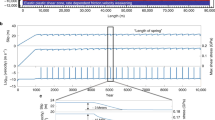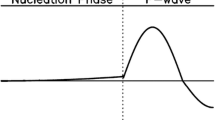Abstract
Important issues with regard to the generation processes of large inland earthquakes include how the stress concentrates and how nucleation starts in the deeper part of the seismogenic zone prior to the mainshock. We propose a model of earthquake generation processes that uses a constitutive law combining friction and flow processes. Using this law, we can represent fault behavior in which frictional slip coexists with flow processes at the frictional-viscous transition zone. We consider a limitted region where viscous deformation is high along the frictional-viscous transition zone, and investigate the role of this region in the nucleation process. During the interseismic period, slip velocity due to flow is much larger than frictional slip velocity in the region of low viscosity in the deeper part of the seismogenic zone. Large slip due to flow in this region is thought to cause stress to concentrate in the surrounding regions, and nucleation starts just above the low-viscosity region. Our numerical simulations indicate that the location of the nucleation process is determined by the nonuniform distribution of the depth of the frictional-viscous transition zone.
Similar content being viewed by others
References
Chester, F. M., A rheologic model for wet crust applied to strike-slip faults, J. Geophys. Res., 100, 13,033–13,044, 1995.
Estrin, Y. and Y. Brchet, On a model of frictional sliding, Pageoph., 147, 1996.
Garatani, K., B. Shibazaki, Y. Iio, T. Sagiya, and H. Okuda, FEM modeling crustal deformation with non-linear visco-elasticity, plasticity, and faulting, Earth Planets Space, 2005 (submitted).
Iio, Y. and Y. Kobayashi, Is the plastic flow uniformly distribted below the seismogenic region?, Earth Planets Space, 54, 1085–1090, 2002.
Iio, Y., Y. Kobayashi, and T. Tada, Large earthquakes initiated by the acceleration of slips on the downward extensions of seismogenic faults, Earth Planet. Sci. Lett., 202, 337–343, 2002.
Ito, K., Regional variations of the cutoff depth of seismicity in the crust and their relation to heat flow and large inland earthquakes, J. Phys. Earth, 38, 223–250, 1990.
Iwasaki, T. and R. Sato, Strain field in a semi-infinite medium due to an inclined rectangular fault, J. Phys. Earth, 27, 285–314, 1979.
Kato, N., A possible model for large preseismic slip on a deeper extension of a seismic rupture plane, Earth Planet. Sci. Lett., 216, 17–25, 2003.
Kato, N. and T. Hirasawa, A numerical study on seismic coupling along subduction zones using a laboratory-derived friction law, Phys. Earth Planet. Inter., 102, 51–68, 1997.
Marone, C., Laboratory-derived frictional laws and their application to seismic faulting, Annu. Rev. Earth Planet. Sci., 94, 12,321–12,335, 1998.
Masuda, K., K. Fujimoto, and T. Arai, A new gas-medium, high-pressure and high-temperature deformation apparatus at AIST, Japan, Earth Planets Space, 54, 1091–1094, 2002.
Nakatani, M., Conceptual and physical clarification of rate and state dependent friction law: Thermally activated rheology of frictional sliding, J. Geophys. Res., 106, 13,347–13,380, 2001.
Okubo, P. G., Dynamic rupture modeling with laboratory-derived constitutive relations, J. Geophys. Res., 94, 12,321–12,335, 1989.
Poirier, J. P., Creep of Crystals, Cambridge University Press, Cambridge, 1985.
Reinen, L. A., Slip styles in a spring-slider model with a laboratory-derived constitutive law for serpentinite, Geophys. Res. Lett., 27, 2037–2040, 2000.
Rice, J. R., Spatio-temporal complexity of slip on a fault, J. Geophys. Res., 98, 9885–9907, 1993.
Scholz, C. H., The Mechanics of Earthquakes and Faulting, Cambridge University Press, 1990.
Shibazaki, B. and Y. Iio, On the physical mechanism of silent slip events along the deeper part of the seismogenic zone, Geophys. Res. Lett., 30, 2003GL017047, 2003.
Shibazaki, B., H. Tanaka, H. Horikawa, and Y. Iio, Modeling slip processes at the deeper part of the seismogenic zone using a constitutive law combining friction and flow laws, Earth Planets Space, 54, 1211–1218, 2002.
Shigematsu, N., K. Fujimoto, T. Ohtani, H. Tanaka, Y. Miyashita, and T. Tomita, Structures of fault zones in the brittle-plastic transition zone of the continental earth’s crust: A case study of the Hatagawa fault zone, Journal of Geography, 112, 897–914, 2003 (in Japanese with English abstract).
Shimamoto, T., A transition between frictional slip and ductile flow undergoing large shearing deformation at room temperature, Science, 231, 711–714, 1986.
Tanaka, H., B. Shibazaki, N. Shigematsu, K. Fujimoto, T. Ohtani, Y. Miyashita, T. Tomita, K. Omura, Y. Kobayashi, and J. Kameda, Growth of plastic shear zone and its duration inferred from theoretical consideration and observation of an ancient shear zone in the granitic crust, Earth Planets Space, 54, 1207–1210, 2002.
Tse, S. T. and J. R. Rice, Crustal earthquake instability in relation to the depth variation of frictional slip properties, J. Geophys. Res., 91, 9452–9472, 1986.
Zhao, D., H. Kanamori, and H. Negishi, Tomography of the source area of the 1995 Kobe earthquake: Evidence for fluids at the hypocenter?, Science, 274, 1891–1894, 1996.
Author information
Authors and Affiliations
Corresponding author
Rights and permissions
About this article
Cite this article
Shibazaki, B., Shigematsu, N. & Tanaka, H. Modeling slips and nucleation processes at the deeper part of the seismogenic zone. Earth Planet Sp 56, 1087–1093 (2004). https://doi.org/10.1186/BF03353327
Received:
Revised:
Accepted:
Published:
Issue Date:
DOI: https://doi.org/10.1186/BF03353327




